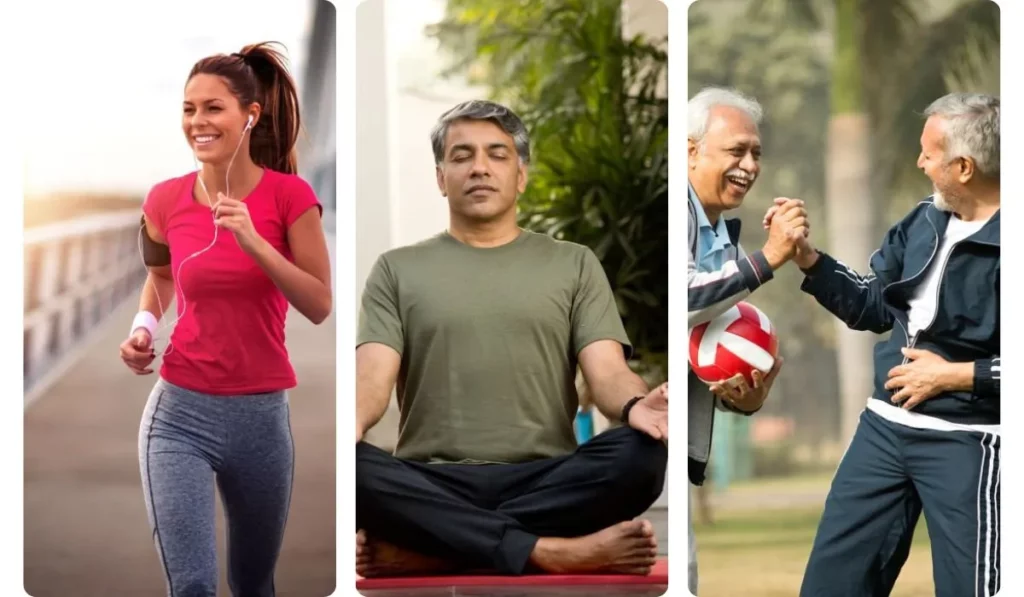Health
What Are The 3 Types Of Fitness? Dimensions and Strategies Explained

Fitness is more than just physical health and strength. True fitness encompasses the mind, body, and social connections. There are three fundamental types of fitness – physical, mental, and social. Developing each dimension leads to greater well-being, resilience, and fulfillment.
This article explains the three fitness types, their interrelation, and proven strategies for improvement. It emphasizes the importance of consistency, tracking progress, and tailoring your fitness journey. Barriers must be overcome to realize the holistic benefits of comprehensive fitness.
What Are The 3 Types Of Fitness?
There are three kinds of fitness – physical, mental, and emotional fitness. Physical fitness involves cardiovascular health, muscle strength, endurance, and flexibility. Mental fitness includes cognitive abilities, critical thinking, and resilience. Emotional fitness refers to the ability to understand and manage emotions skillfully, maintain satisfying relationships, and cope with life’s stresses. Working on all the three kinds of fitness leads to overall wellbeing.

Physical Fitness: Building A Strong Body
Physical fitness involves cardiovascular endurance, muscle strength, flexibility, and healthy body composition. Cardiovascular exercise improves heart and lung capacity. Strength training builds muscle and protects joints. Stretching enhances flexibility and range of motion. A balanced diet helps maintain healthy body fat and weight levels.
Physical activity reduces disease risk and boosts energy. It also alleviates anxiety, mood disorders, and depression. Exercise releases feel-good endorphins and the brain chemicals serotonin and dopamine. Creating healthy physical fitness habits provides confidence, self-esteem, and a sense of control.
Mental Fitness: Nurturing Cognitive Well-being
Mental fitness refers to cognitive health, critical thinking, emotional intelligence, and resilience. Mentally fit individuals adapt well to challenges, creatively problem-solve, manage stress effectively, and display grit. Nurturing mental fitness comes from learning new skills, solving puzzles, practicing mindfulness, and developing a growth mindset. Meditation and reflection build self-awareness.
Logging thoughts in a journal can reveal unhelpful thinking patterns. Shared intellectual pursuits, continued education, and immersing yourself in art and culture expand mental horizons. Mental fitness provides a sense of purpose, cognitive stimulation, and tools for rising above adversity. It enables making wise decisions that uplift your life.
Social Fitness: Cultivating Meaningful Connections
Social fitness involves developing meaningful relationships and positively contributing to communities. Socially fit individuals communicate effectively, cultivate intimacy, empathize, and cooperate with diverse groups.
Nurturing social fitness comes from displaying warmth and kindness, actively listening, resolving conflict maturely, and engaging in volunteer work. Shared meaningful experiences like attending live music and art events, recreational sports, conferences, religious gatherings, and various community events build bonds. Social connections support mental health, reduce stress, and increase fulfillment. A strong social network provides a sense of belonging, emotional security, and motivation to improve oneself.
Read More:- How Does Running In The Morning Affect Your Overall Health?
The Interplay Of Fitness Dimensions
The three fitness dimensions intersect and enable one another. Physical exercise sharpens mental acuity while team sports foster social skills. Mental resilience helps overcome physical setbacks and empowers healthier choices. Meaningful social ties provide encouragement to continue positive fitness habits.
Each dimension augments and compounds the benefits of the other two. Holistic fitness nourishes the body, stimulates the mind, and connects to others. This multidimensional approach leads to greater health and happiness.
Strategies For Improving Each Fitness Dimension
✔ Practice physical exercise like cardio, strength training, and stretching several times a week.
✔ Try to challenge your mind with strategy games, learning new skills and languages.
✔ Meditate, express gratitude, and visualize success to build mental resilience. Make social dates, share activities, and join groups with like-minded interests.
✔ Start each day by setting goals. Schedule fitness time in your calendar to create habits.
✔ Tracking progress with fitness devices or journals creates accountability.
✔ Consistent incremental improvement across all three dimensions leads to compounding holistic fitness benefits.
Importance of Consistency and Progress Tracking
The key to fitness success is consistency. Workout routines and healthy habits must be prioritized daily. Tracking progress with metrics like workout logs, heart rate monitors, and progress photos creates accountability and motivation.
Periodic fitness assessments identify areas needing improvement. Consistency coupled with tracking fosters continual progress as small gains accumulate into transformative change. Fitness is a lifelong endeavor, not a short sprint. The journey brings greater fulfillment when progress is measurable.
Tailoring Your Fitness Journey
Fitness success requires customizing activities and nutrition to suit your unique interests, body, schedule, and lifestyle. Prioritize activities you enjoy and find some aspect of each fitness type you can sustain long-term.
Embrace a growth mindset and periodically reevaluate goals and adjust your program to prevent plateaus. Lifestyle factors like occupation, family life, and abilities dictate optimal strategies. Own your unique fitness journey.
Overcoming Barriers to Fitness Improvement
Progress plateauing, lack of results, boredom, and busy schedules can impede fitness efforts. Staying motivated is challenging. Remind yourself of your purpose and envision an energized, healthy future self. Adjust your program and sets new goals to push past plateaus. Practice resilience and don’t give up after lapses or setbacks.
Prioritize fitness in your schedule and wake up early to exercise if needed. Work through discomfort recognizing pain as a weakness leaving the body. Track metrics to stay focused on continual improvement. Proper rest and nutrition fuel fitness gains. Overcoming barriers requires grit, flexibility, and purpose. The rewards justify the required mindset and lifestyle shifts.
The Holistic Benefits of a Comprehensive Fitness Approach
A balanced fitness approach nourishes every dimension of your life. You gain physical strength and mobility, mental clarity and emotional intelligence, and meaningful social connections. Energy improves, disease risks decline, and confidence soars.
Comprehensive fitness leads to feeling empowered in your body, inspired in your mind, supported socially and propelled toward your highest potential. Overall life satisfaction, performance, and well-being all benefit from dedication across physical, mental, and social fitness.
Conclusion
Fitness is not just a number on a scale. It is a lifestyle that enhances health, cognition, relationships, and resilience. Aim for progress, not perfection. Be consistent, track metrics, and customize your approach.
Overcome barriers through flexibility and purpose. Comprehensive fitness leads to greater confidence, energy, and fulfillment. Prioritize self-care through the cultivation of your body, mind, and social ties. True fitness requires dedication to all three interconnected dimensions. The rewards of improved well-being are immeasurable. Start your comprehensive fitness journey today.
Read More: Billie Eilish Opens Up About Her Fitness Transformation
